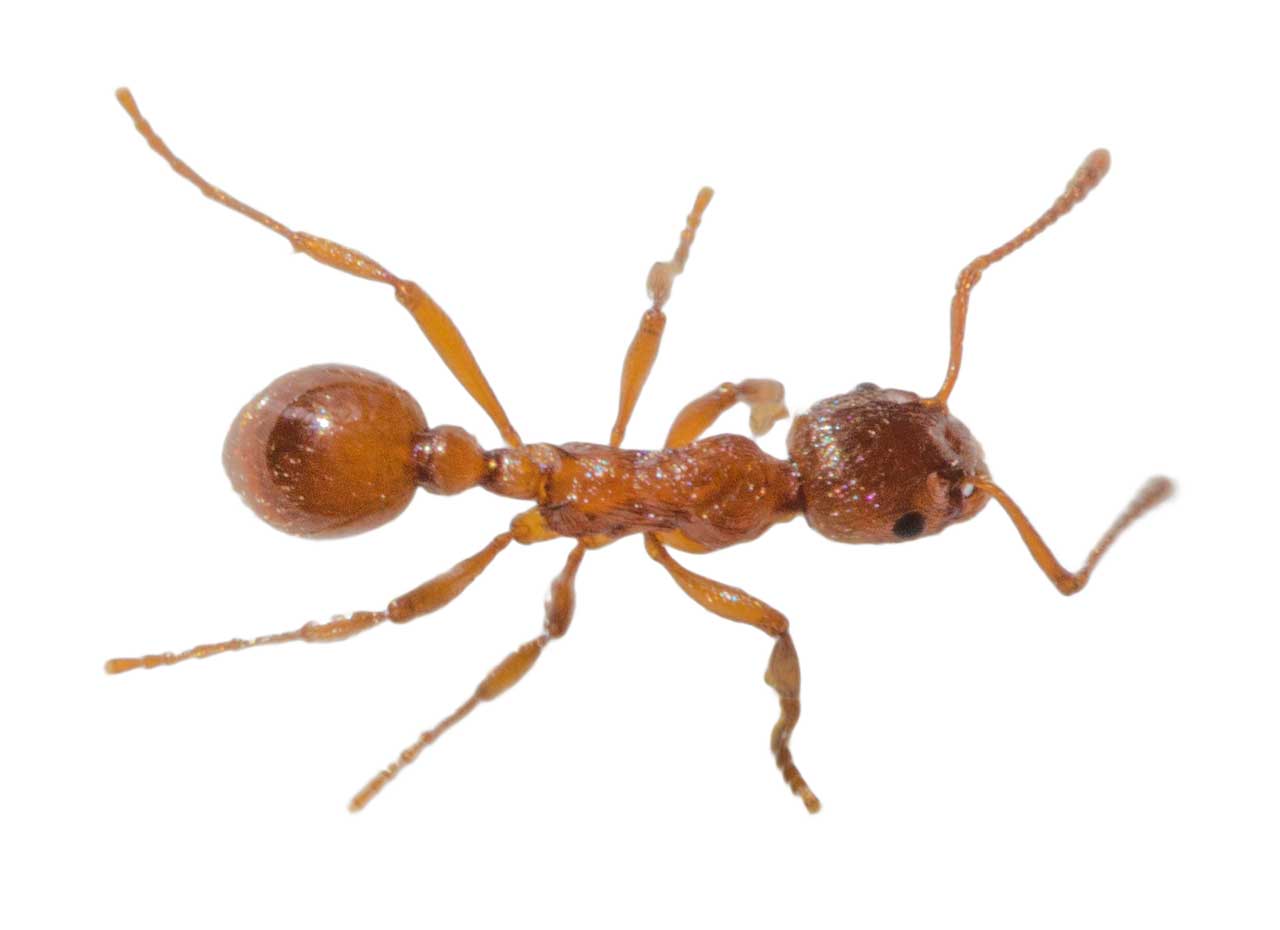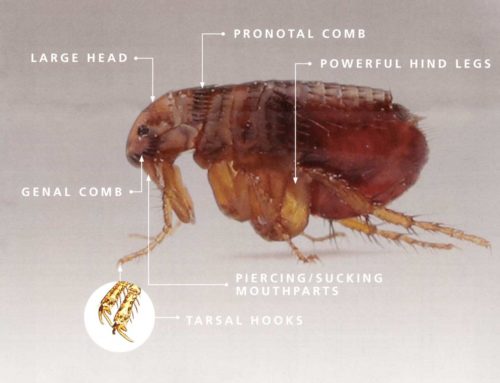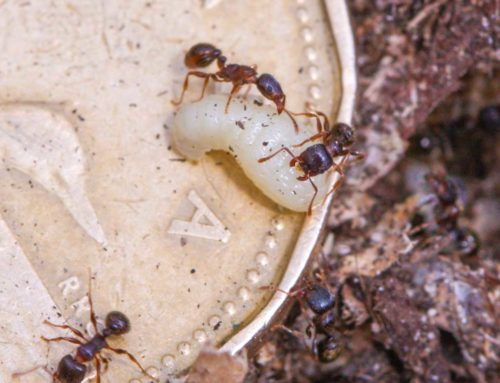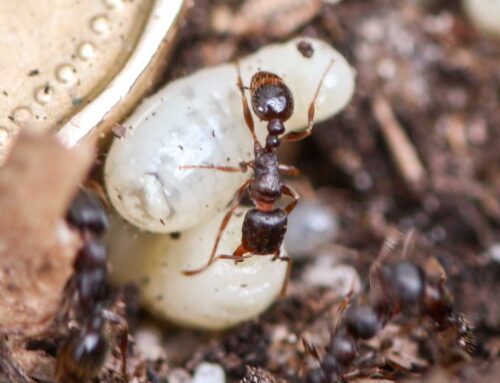Fire Ants Extermination
and Pest Control in Toronto
Fire Ants Extermination
We deliver non-intrusive Fire Ants Extermination and Pest Control in Toronto utilizing latest technology in Bait matrix formulation by Bayer® or BASF®. This approach is fool proof and does not require you to empty cabinets or vacate your residence!
Appearance
The bodies of fire ants, like all insects’ bodies, are broken up into three sections: the head, the thorax, and the abdomen, with three pairs of legs and a pair of antennae. Fire ants can be distinguished from other ants by their copper brown head and body with a darker abdomen. The worker ants are blackish to reddish, and their size varies from 2mm to 6 mm (0.12 in to 0.24 in). These different sizes of the ants can all exist in the same nest.
Behavior
A typical fire ant colony produces large mounds in open areas, and feeds mostly on young plants, seeds, and sometimes crickets. Fire ants often attack small animals and can kill them. Unlike many other ants, which bite and then spray acid on the wound, fire ants only bite to get a grip and then sting (from the abdomen) and inject a toxic alkaloid venom called Solenopsin, a compound from the class of piperidines. For humans, this is a painful sting, a sensation similar to what one feels when burned by fire—hence the name fire ant—and the aftereffects of the sting can be deadly to sensitive individuals. Although fire ants do not typically seek out and attack the face, they are as likely to attack an exposed and vulnerable face as any other body part. The venom is both insecticidal and antibiotic. Researchers have proposed that nurse workers will spray their brood to protect them from microorganisms.
Fire ants nest in the soil, often near moist areas, such as river banks, pond edges, watered lawns and highway edges. Usually the nest will not be visible as it will be built under objects such as timber, logs, rocks, pavers, bricks, etc. If there is no cover for nesting, dome-shaped mounds will be constructed, but this is usually only found in open spaces such as fields, parks and lawns. These mounds can reach heights of 40 cm (15.7 in).
Colonies are founded by small groups of queens or single queens. Even if only one queen survives, within a month or so the colony can expand to thousands of individuals. Some colonies may be polygynous (having multiple queens per nest).
Roles of Ants
A queen is generally the largest individual in the colony. The primary function of the queen is reproduction; she may live for 6-7 years and produce up to 1,500 eggs per day. Many fire ant colonies will have more than one queen. And Males mate with the queen ant in order to produce eggs.
Symptoms and first aid
The venom of a fire ant sting causes stinging and swells into a bump. This can cause much pain and irritation at times, especially when stung repeatedly by several at once. The bump often forms into a white pustule, which is at risk of becoming infected if scratched, however if left alone usually go down within a few days. The pustules are unattractive and uncomfortable while active and, if the sting sites become infected, can turn into scars. Additionally, some people are allergic to the venom and, as with many allergies, may experience anaphylaxis, which requires emergency treatment. An antihistamine or topical corticosteroids may help reduce the itching.
First aid for fire ant bites includes external treatments and oral medicines.
External treatments: a topical steroid cream (hydrocortisone), or one containing aloe vera.
Oral medicines: antihistamines.
Patients who experience severe or life threatening allergic reactions to fire ant insect stings should visit a doctor or hospital immediately upon contact as these reactions can result in death. These more severe reactions include severe chest pain, nausea, severe sweating, loss of breath, serious swelling, or slurred speech.
Our preferred extermination technique for an infestation of Fire Ants
We would inspect and determine if Bait or Spray is more appropriate in the given situation.
Typically, if the ants inside the property are interested in foods, we would deploy suitable baits. Fire Ants will find this bait during their foraging activities. Fire Ants will not only feed on this bait but also carry it back to the nest to feed the Fire Ants that are devoted to maintaining the colony. Some Fire Ants may have multiple feeding on the deployed bait as the bait’s lethal characteristics do not become evident immediately upon ingestion.
So in most situation, by about 5 weeks time, most Fire Ants would have become affected by the hidden poison in the bait. We expect that all Fire Ants would have expired by now. The bait is usually in the form of a paste or a gel or is granular.
Expected Results:
When the Fire Ants finds the Bait during normal foraging activities and ingests it as desirable food, then Fire Ants is considered to have had a lethal dose. The Fire Ants expire after some time having been affected by the presence of the active ingredient of the Bait in the Fire Ants’s physiology. The Fire Ants gets sick and dies off. The body debris of dead Fire Ants acts as secondary source of poisoning for the remainder population of Fire Ants. Thus the pest’s nesting environment is also turned into a terminal trap.
Warranty:
Our standard service includes a 7 months limited warranty. It may takes between 3 to 5 weeks for entire of the Fire Ants infestation to die off. If the infestation does not completely die off or if the Fire Ants infestation revives, then we deliver a second application free of cost. In rare instances where a 3rd application visit is requested within 7 months, it is considered an exceptional situation and a fee of 28% is charged for the service.








